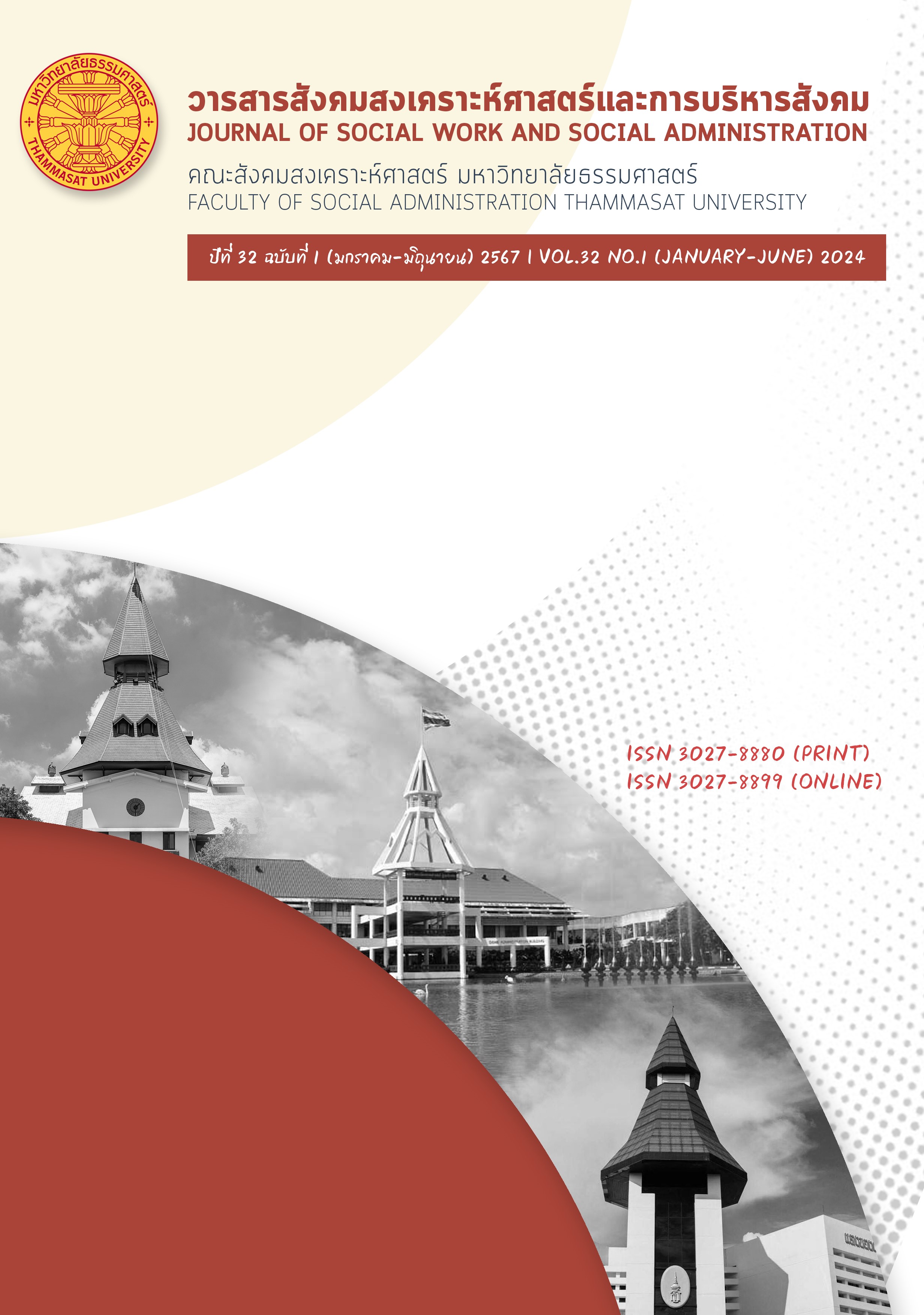แนวทางการยกระดับและพัฒนาช่องทางการตลาดผลิตภัณฑ์จากสินค้าเกษตรตกเกรดเหลือทิ้งในชุมชน กรณีศึกษา ชุมชนจอมประทัด จังหวัดราชบุรี
คำสำคัญ:
การยกระดับสินค้าเกษตรเหลือทิ้ง, การพัฒนาช่องทางการตลาด, ผลิตภัณฑ์ชุมชน, กาบกล้วยบทคัดย่อ
การวิจัยครั้งนี้มีวัตถุประสงค์เพื่อ 1) พัฒนาผลิตภัณฑ์จากสินค้าเกษตรตกเกรดเหลือทิ้งในชุมชน 2) พัฒนาช่องทางการตลาดสำหรับสินค้าเกษตรตกเกรดเหลือทิ้งในตำบลจอมประทัด อำเภอวัดเพลง จังหวัดราชบุรี การวิจัยครั้งนี้ดำเนินการวิจัยตามขั้นตอนของทฤษฎีการเรียนรู้สังคม (Social learning process , SLP) ประกอบด้วย 6 ขั้นตอน ได้แก่ การตระหนักรู้ปัญหา หาทางเลือกการแก้ไขปัญหา ตัดสินใจเลือกทางเลือก การเรียนรู้และลงมือทำการประเมินและการปรับปรุง การพัฒนาผลิตภัณฑ์ชุมชนจากสินค้าเกษตรเหลือทิ้งเกิดจากประชาชนในชุมชนสะท้อนปัญหาต้นกล้วยที่เหลือทิ้งจำนวนมากต้องการแปรรูปต้นกล้วยให้มีมูลค่าเพิ่มขึ้น กลายเป็นคำถามการวิจัย “กาบกล้วยสามารถนำมาใช้ประโยชน์และสร้างมูลค่าเพิ่มได้อย่างไร” ผู้วิจัยจึงดำเนินการประชาสัมพันธ์เพื่อหากลุ่มผู้สนใจซึ่งตระหนักในปัญหาขยะจากเศษวัสดุเหลือทิ้งทางการเกษตร ในพื้นที่ตำบลจอมประทัดและตำบลใกล้เคียง จำนวน 20 ราย ประกอบด้วยสมาชิกของกลุ่มแม่บ้านเกษตรกร ผู้นำชุมชน ผู้สูงอายุ ผู้ว่างงานเข้าร่วมโครงการ
ผลการวิจัยพบว่า 1) การพัฒนาผลิตภัณฑ์จากวัสดุเหลือทิ้งทางการเกษตรผ่านการอบรมแปรรูปสินค้าเกษตรเหลือทิ้งต้นกล้วยน้ำว้าเป็นกระดาษกาบกล้วย ซึ่งสามารถแปรรูปเป็นดอกไม้จันท์ พวงหรีดกาบกล้วย กระเป๋ากาบกล้วย ทำให้รายได้ของกลุ่มผู้เข้ารับการอบรมเพิ่มขึ้นร้อยละ 2) การสร้างช่องทางการตลาดเพื่อเพิ่มรายได้ให้กับกลุ่ม แบ่งออกเป็น 2 ช่องทาง คือ การขายออนไลน์ผ่านเพจเฟสบุ๊คของสมาชิกและขายทางหน้าร้านของกลุ่มแม่บ้าน ซึ่งสินค้าที่ผลิตขายมี 2 ชนิดคือ กระดาษกาบกล้วยน้ำว้าผลิตส่งตานีสยาม และกระเป๋าจากกาบกล้วยน้ำว้าผลิตให้เฉพาะลูกค้าที่สั่งผ่านกลุ่มแม่บ้าน การขายกระดาษกาบกล้วยน้ำว้าและกระเป๋าจากกาบกล้วยน้ำว้าช่วยสร้างงานและเพิ่มรายได้ให้กลุ่มผู้สูงอายุในชุมชน ช่วยเสริมสร้างความร่วมมือในชุมชน ลดความเครียดให้กับผู้สูงอายุ ซึ่งการพัฒนาผลิตภัณฑ์ชุมชนจากสินค้าเกษตรตกเกรดเหลือทิ้งในชุมชนและการพัฒนาช่องทางการตลาดมีผลกระทบต่อชุมชน สร้างงาน เพิ่มรายได้และความยั่งยืนในการผลิตและตลาดสินค้าเกษตรในระยะยาวและยั่งยืน
เอกสารอ้างอิง
กิติศักดิ์ ทองมีทิพย์. (2564). พัฒนาการเกษตรกรรมของประเทศไทย: ในมิติด้านการพัฒนาชุมชนและคุณภาพชีวิต. วารสารพัฒนศาสตร์, 4(1), 132-162.
กศิพัฎญ์ ทองแกม และ โฆษิต แพงสร้อย. (2562). ปัญหาและแนวทางส่งเสริมการขายสินค้าโอทอปบนตลาดออนไลน์เชิงพุทธในจังหวัดอุดรธานี. วารสารมหาจุฬานาครทรรศน์, 6(9), 4627-4644.
เขมิกา ธนธำรงกุล, ปรีดา ศรีนฤวรรณ, ภูษณิศา เตชเถกิง และ ภัทริภา มณีพันธ์. (2563). โมเดลธุรกิจเพื่อสร้างความได้เปรียบในการแข่งขันของธุรกิจจำหน่ายเครื่องจักรการเกษตร ในจังหวัดเชียงใหม่, วารสารวิชาการมหาวิทยาลัยราชภัฎศรีสะเกษ, 14(2), 51-62.
จริยาภรณ์ อุ่นวงษ์. (2556). การสร้างมูลค่าเพิ่มวัสดุเหลือใช้จากผลิตภัณฑ์ชุมชนหมู่บ้านเรียงแถวใต้ ตำบลนิคมลำโดมน้อย อำเภอสิรินธร จังหวัดอุบลราชธานี, วารสารวิจัยเพื่อการพัฒนาเชิงพื้นที่, 5(3), 5-20.
จิตพนธ์ ชุมเกตุ. (2560). การพัฒนาผลิตภัณฑ์จากภูมิปัญญาท้องถิ่นเพื่อเพิ่มประสิทธิภาพทางการจัดการชุมชนอย่างยั่งยืนของชุมชนไทยมุสลิม อำเภอชะอำ จังหวัดเพชรบุรี. รายงานวิจัย. มหาวิทยาลัยศิลปากร.
จิติมา วรรณศรี, วิทยา จันทร์ศิลา และ สถิรพร เชาวน์ชัย. (2565). รูปแบบการวิจัยเชิงปฏิบัติการเพื่อส่งเสริมทักษะการพัฒนานวัตกรรมของครู. วารสารสังคมศาสตร์และมานุษยวิทยาเชิงพุทธ, 7(7), 219-232.
ฉัตรชัย อินทสังข์. (2554). ตลาดเฉพาะกลุ่ม หนทางสู่ความสำเร็จของธุรกิจขนาดกลางและขนาดย่อม. วารสารปัญญาภิวัฒน์, 2(2), 42-49.
ณฐพงศ์ ใจซื่อตรง. (2563). การพัฒนาผลิตภัณฑ์ชุมชนสู่การแข่งขันทางการตลาด บ้านสมใจ ตำบลใจดี อำเภอขุขันธ์ จังหวัดศรีสะเกษ. วารสารวิทยาการจัดการปริทัศน์, 22(2), 121-130.
ธีระวุฒิ ปัญญา. (2556). อาหารคือยาที่ดีสุดของมนุษยชาติ. กรุงเทพฯ: กู๊ดไลฟ์.
นิยม กริ่มใจ. (2565). ธุรกิจเปลี่ยนผ่านสู่วิถีปกติใหม่ ด้วยโมเดลธุรกิจ CANVAS. วารสารวิชาการ สถาบันเทคโนโลยีแห่งสุวรรณภูมิ, 8(1), 66-78.
พิชญ์สิณี รัตนานุพงศ์, ปรีชา พันธุ์แน่น, ดวงทิพย์ จันทร์อ่วม, มุทิตา อารยะเศรษฐากร และ ชเนตตี พิพัฒนางกูร. (2564). การพัฒนาศักยภาพกลุ่มแม่บ้านผู้ผลิตผลิตภัณฑ์ชุมชน โดยการมีส่วนร่วมของชุมชนร่วมพัฒนา เขตหลักสี่ กรุงเทพมหานคร. วารสารร่มพฤกษ์ มหาวิทยาลัยเกริก, 39(1), 61-84.
พัสรินณ์ พันธุ์แน่น, เพ็ญประภา ภัทรานุกรม, ดาวพระศุกร์ ทองกลิ่น และดวงทิพย์ จันทร์อ่วม. (2566). งานวิจัยเพื่อท้องถิ่น: การลดความเหลื่อมล้ำเชิงเศรษฐกิจและเชิงพื้นที่ในชุมชนคนจนเมือง. วารสารร่มพฤกษ์ มหาวิทยาลัยเกริก, 41(3), 169-189.
สามารถ ใจเตี้ย. (2564). การใช้ประโยชน์วัสดุเหลือใช้ทางการเกษตรของเกษตรกรในเทศบาลตำบลขี้เหล็ก อำเภอแม่ริม จังหวัดเชียงใหม่. วารสารวิจัยและส่งเสริมมวิชาการเกษตร, 38(2), 79-88.
หทัยชนก สุคันธศรี. (2562). การศึกษาเส้นทางผู้บริโภคในช่องทางออนไลน์ กรณีศึกษาอุตสาหกรรมเครื่องสำอาง. วิทยาศาสตร์มหาบัณฑิต, มหาวิทยาลัยธรรมศาสตร์.
อติญาณ์ ศรเกษตริน, อัจฉราวดี ศรียะศักดิ์, สถาพร แถวจันทึก, วารุณี เกตุอินทร์ และ วิไลวรรณ คมขำ. (2564). การวิจัยปฏิบัติการแบบมีส่วนร่วมของชุมชนในการพัฒนาคุณภาพชีวิตผู้สูงอายุ ตำบลธงชัย จังหวัดเพชรบุรี. วารสารเครือข่ายวิทยาลัยพยาบาลและการสาธารณสุขภาคใต้, 8(1), 85-99.
อภิญญ์พัทร์ กุสิยารังสิทธ์. (2566). กลยุทธ์การประชาสัมพันธ์สินค้าโอทอปกรุงเทพมหานคร. วารสารนิเทศศาสตรปริทัศน์, 27(2). 65-80.
Osterwalder, A., & Pigneur, Y. (2010). Business Model Generation: A Handbook for Visionaries, Game Changers, and Challengers. New Jersey: Wiley.
ดาวน์โหลด
เผยแพร่แล้ว
รูปแบบการอ้างอิง
ฉบับ
ประเภทบทความ
สัญญาอนุญาต
ลิขสิทธิ์ (c) 2024 วารสารสังคมสงเคราะห์ศาสตร์และการบริหารสังคม

อนุญาตภายใต้เงื่อนไข Creative Commons Attribution-NonCommercial-NoDerivatives 4.0 International License.
ผลงานที่ตีพิมพ์ในวารสารสังคมสงเคราะห์ศาสตร์เป็นลิขสิทธิ์ของวารสารสังคมสงเคราะห์ศาสตร์ มหาวิทยาลัยธรรมศาสตร์ และวารสารสังคมสงเคราะห์ศาสตร์ มหาวิทยาลัยธรรมศาสตร์ ขอสงวนสิทธิในการเผยแพร่ผลงานที่ตีพิมพ์ในแบบรูปเล่มและทางสื่ออิเล็กทรอนิกส์อื่นใด
บทความหรือข้อความคิดเห็นใดๆ ที่ปรากฏในวารสารสังคมสงเคราะห์ศาสตร์เป็นความรับผิดชอบของผู้เขียนโดยเฉพาะ คณะสังคมสงเคราะห์ศาสตร์ มหาวิทยาลัยธรรมศาสตร์ และบรรณาธิการไม่จําเป็นต้องเห็นด้วยหรือร่วมรับผิดชอบใดๆ



